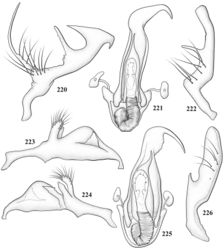Pilophoropsidea dimidiata
| Notice: | This page is derived from the original publication listed below, whose author(s) should always be credited. Further contributors may edit and improve the content of this page and, consequently, need to be credited as well (see page history). Any assessment of factual correctness requires a careful review of the original article as well as of subsequent contributions.
If you are uncertain whether your planned contribution is correct or not, we suggest that you use the associated discussion page instead of editing the page directly. This page should be cited as follows (rationale):
Citation formats to copy and paste
BibTeX: @article{Henry2015ZooKeys, RIS/ Endnote: TY - JOUR Wikipedia/ Citizendium: <ref name="Henry2015ZooKeys">{{Citation See also the citation download page at the journal. |
Ordo: Hemiptera
Familia: Miridae
Genus: Pilophoropsidea
Name
Pilophoropsidea dimidiata Henry sp. n. – Wikispecies link – ZooBank link – Pensoft Profile
Diagnosis
This species (Fig. 56) is recognized by the small size; the brown to reddishbrown coloration; the shiny to satiny brown pronotum having a finely granulate surface; and the male genitalia, particularly the stout left paramere (Fig. 223) with a triangular-shaped lateral process.
Description
Male (n = 2; holotype mesurements in parentheses): Length 3.76 mm (3.84) mm, width 1.24 mm (1.18 mm). Head: Width 0.76 mm (0.74 mm), interocular width 0.40 mm (0.38 mm). Labium: Length 1.40 mm (1.44 mm). Antenna: Segment I, length 0.30 mm (0.26 mm); II, length 0.94 mm (0.92 mm); III, 0.58 mm (0.53 mm); IV, 0.54 mm (0.52 mm). Pronotum: Length 0.83 mm (0.80 mm), basal width 1.06 mm (1.10 mm).
Coloration: Head: Reddish brown. Antenna: Segment I pale brown, with a slender red to brown mark on basal third; segment II brown, darker apically; segment III and IV reddish brown. Pronotum: Reddish brown to fuscous. Scutellum: Reddish brown to dark brown. Hemelytron: Uniformly polished, orange brown on basal half, brown to fuscous on apical third, with a narrow band of silvery scale-like setae at base of clavus and a wider band through middle of corium and apical third of clavus, intermixed with a row of long, erect, pale, simple setae on clavus and inner corial margin bordering membrane; membrane smoky black beyond apex of cuneus, pale or whitish across areoles and between. Ventral surface: Shiny reddish brown, becoming fuscous on abdomen; ostiolar area white, with large anterior knob at end of scent channel dull red. Legs: Procoxa brown, red apically, middle and hind coxae whitish, base of middle coxa brown; femora brown, apex of hind femur pale on ventral aspect; tibiae reddish brown to dark brown, fore and middle tibiae pale on apical 1/4; tarsi and claws pale brown.
Structure, texture, and vestiture: Head: Finely granulate, transverse striations on frons absent or extremely vague, pubescence short, recumbent, with a few long, erect, pale setae across base of vertex and basal area around clypeus. Labium: Extending to bases of hind coxae or to posterior margin of metasternum. Antenna: Segment II slender, only slightly thickening to apex. Pronotum: Disc and calli finely granulate, satiny, anterior collar transversely rugose, setae short, sparse, and recumbent.
Male genitalia: Aperture with a short, stout spine along margin just above left paramere. Left paramere (Figs 223, 224): stout, truncate apex narrowed and decurved; middle with three processes, one thick and rounded apically and two acute apically (with anterior most one hidden from view in caudal aspect, i.e. in situ), and a central marginally crenulate triangular flange at widest part. Right paramere (Fig. 226): stout, with a lateral, hook-like process directed upward. Phallotheca (Fig. 225): stout, with a long, slender, sharply recurved hook.
Female: Unknown.
Etymology
The specific epithet dimidiata is used to denote the small size of this species.
Distribution
Durango, Mexico.
Host
Unknown.
Type material
Holotype ♂: MEXICO: Durango: 9 mi. W La Ciudad Durango, 9000’, 1 July 1964, L. A. Kelton (00167381) (CNC). Paratype: MEXICO: Durango: 24 mi. W. La Ciudad, Durango, 7000’, 21 July 1964, L. A. Kelton, 1♂ (USNM) [00162217].
Original Description
- Henry, T; 2015: Revision of the Ceratocapsine Renodaeus group: Marinonicoris, Pilophoropsis, Renodaeus, and Zanchisme, with descriptions of four new genera (Heteroptera, Miridae, Orthotylinae) ZooKeys, (490): 1-156. doi
Images
|

